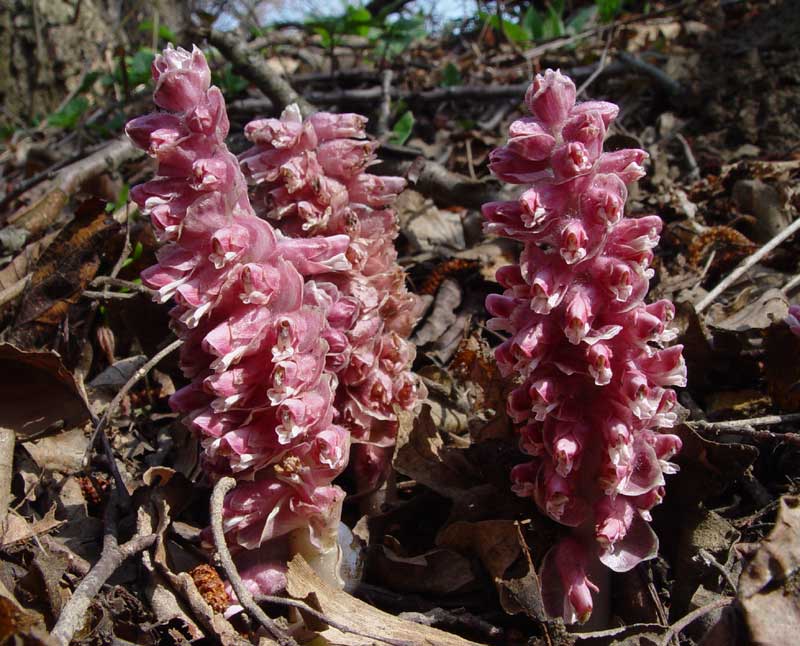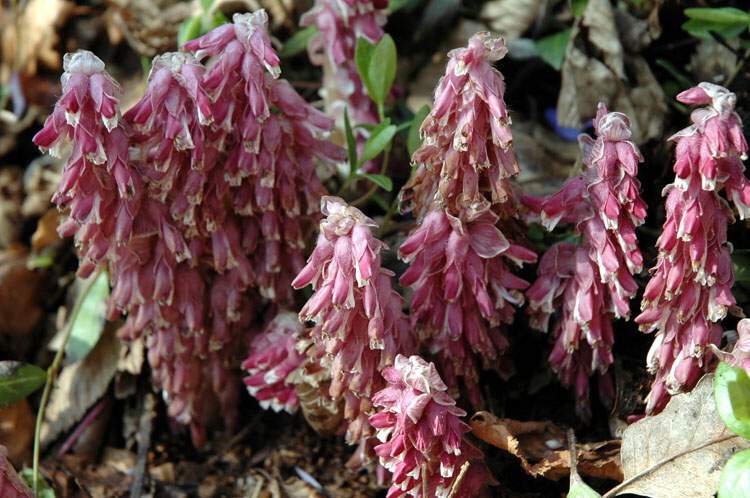Lathraea squamaria
Schuppenwurz ( Lathraea squamaria )
The Ordinary Schuppenwurz ( Lathraea squamaria ), also Upright Schuppenwurz, is a species of the genus the scales Wurzen ( Lathraea ) in the family of broomrape family ( Orobanchaceae ).
Description
The Ordinary Schuppenwurz is a perennial, herbaceous, almost devoid of chlorophyll parasitic plant, the above-ground forms an approximately 10-30 cm high rung.
The flowers are dull pink to purple - colored and arranged in a bent-over einseitswendigen grape.
Underground it forms a richly branched, up to 2 m long rhizome, which can reach a weight of up to 5 kg. The rhizome is covered with fleshy starchy scales representing the converted low platelets with memory function.
The rhizome also has small suckers ( haustoria ) that penetrate the plant into the tissue of trees or other host plants and there sucks the juice.
Since the Schuppenwurz does not form leaves, transpiration, sucks the assimilates from the roots to the upper parts of the plant is missing. Therefore, the stem has special water glands ( hydathodes ) which maintain the water potential between host and parasite by actively excrete or absorb water.
Occurrence
The Schuppenwurz blooms from March to April right after the snow melts, when the host trees are just starting with the water transport. However, it is only at the age of approximately 10 years to a Blühreife. The Schuppenwurz comes across Germany before and is scattered sporadically also found in other parts of Europe and West Asia.
Ecology
The Schuppenwurz is a Geophyt and survived the winter on her richly branched rhizome. She is a full parasites ( Holoparasit ) and is considered one of the bleeding sap parasites ( Xylemparasiten ) because it occupies a special status among the holoparasites by tapping the sap from the xylem of the hosts and not as usual only the phloem is tapped. Normally, the xylem of the host plants, which are almost always trees, woody. Since the xylem of the trees, however, is saturated with organic compounds and plant sap in the spring, which allows the Schuppenwurz to blossom in the spring. You parasitized primarily at hazels, alders, poplars, willows and beeches.
Pollinators are insects, especially bumblebees and ( honey ) bees. Not infrequently, the vorweiblichen ( proterogynen ) flowers are also pollinated by the wind ( anemophily ). In unfavorable years, the flowers can also be formed underground. It may then come for pollination without the flowers open ( cleistogamy ). The fruit set is always very high, almost all flowers develop into fruits.
The long-lived seeds have to be closer than 1 cm are at the root host to germinate can. They are mostly spread by wind, water or by ants.
Etymology
The German name is derived from the fleshy, whitish, starchy storage shed from the rhizome. The botanical epithet squamaria also refers to the shed (Latin squama ' scale '). The genus name indicates that the plant is often largely hidden (Greek lathraios ' hidden ') is in the ground.









